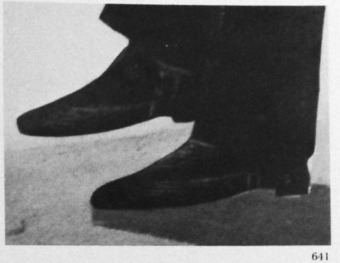Metford, Samuel (McKechnie Section 1)
Recorded by Jackson (Dictionary) and Mrs van Leer Carrick (A History of American Silhouettes). Most authorities agree about the main events of Samuel Metford's life. He was born in Glastonbury, Somerset, of Quaker stock, in 1810. His father (Joseph Metford, of Glastonbury) married a Miss Elizabeth Rawes in 1801. Mayne refers to this artist as 'Sam Miles Metford'. There seems to be no other record of the middle name of 'Miles'; Mayne may have seen a silhouette bearing Metford's signature, with this second Christian name included.
Samuel Metford went to the United States in c. 1834, and eventually took American citizenship. He would therefore have been aged about twenty-four when he left England, and one would think that, since he was to make a career in profile work for the rest of his life, he would have taken a number of silhouettes in England by the time of his departure. Only one example dating from before 1834, however, has come to light: a full-length silhouette by Metford of his father. This, measuring 91/2 x 8 in., shows the figure standing and is inscribed on the back 'Joseph Metford, born 12th. month, 19th. 1776' (that is, 19 December 1776). The piece appears to have been taken in c. 1830, and is therefore an early example of Metford's work, taken before his sojourn in the United States. It is in the possession of Mrs Melanie Buck.
Metford worked in the United States for about ten years. He seems to have centred his activities on Connecticut, but no doubt visited neighbouring states. He was certainly in New Haven in 1842, and had an address there at 111 Chapel Street. Jackson records two seated full-length silhouettes (illustrated by Mrs Carrick) of the Hon. Davis Dagge and the Hon. Nathan Smith, taken in New Haven in 1842.
Metford returned to England in c. 1844. He was certainly in practice as a silhouette artist in Lancashire by 1845, for this is the date on a full-length silhouette of a man, owned by the Municipal Library in Warrington. He continued to work as a silhouette artist until 1865, when he returned to the United States. If taking silhouettes was Metford's main occupation, a good deal of his work must surely survive from these twenty years. There seems to be no evidence that Metford worked either in Bath (a haven for travelling silhouette artists) or in Brighton (where other artists were making a reasonable living). Metford seems to have chosen the north of England. An example in my collection bears the label of a Birkenhead frame-maker, two of the illustrated examples were taken in Warrington, and we know that in 1846 the artist was in Manchester. 534
Jackson tells us that 'many of his silhouettes are to be found in Scotland', which implies that Metford probably used centres in Edinburgh and Glasgow.
The illustrated examples cover the period c. 1845 to c. 1853, or perhaps a little later. Whether Metford continued making silhouettes up to his departure for the United States in 1865 is not known, but no example which I have examined suggests a date of the early 1860s. Possibly he cut silhouettes in the United States during the years 1866-67. His whereabouts in the United States during these years, however, are not recorded.
During or after 1867 Metford returned to England: not to the north, but to Somerset. Some writers state that he died in 1890, but Carrick, and later Woodiwiss, give the year 1896, and state that the artist died in Weston-super-Mare.
Jackson states (though Mrs Carrick denies) that in 1801 Samuel Metford married. Soon after the marriage his wife Elizabeth became mentally afflicted, and became an inmate of The Retreat in York. In consequence, Metford had no descendants. The Quaker community of the time in the north of England had closely intermarried, and there were many solid ties of friendship between the various quaker families. Metford came to an agreement with one of his Quaker friends, named Warner, that Warner's next son should be named Metford. The artist probably helped to educate the boy who was in due course born and named after him. I was told this story by the grandson of Metford Warner, as the boy was called. It bears out the assumption of previous writers that Metford was of Quaker stock.
It is fortunate that Metford signed most of his work; it would otherwise be hard to identify, since it varied greatly both in quality and style of painting. Mayne mentions bust-length profiles; these I have not seen, and unless signed would be very difficult to identify.
Metford's full-length portraits are embellished either in gold paint, Chinese white, or yellow-ochre water-colour. Those painted in gold vary greatly in quality: in some cases the gold is thinly and inartistically applied; in others it is applied with considerable skill. Silhouettes with the detail painted in Chinese white are usually not of a high standard; I own an especially poor example. Those in yellow ochre (which Metford appears to have used in body colour, which was necessary to cover the black paper from which he cut the profiles) are good; all the detail is shown with care and with skilled brushwork. (It is possible that Metford used Naples yellow, itself an opaque pigment, for these examples.) 537 233 539
Although some of Metford's male sitters are seen wearing the fashionable half-boot of the 1840s (made with a somewhat pointed toe and with a small heel), Metford often cut his sitter's heels too small.
Some of Metford's silhouettes are set against lithographed interior backgrounds. Woodiwiss (British Silhouettes) mentions that many of these backgrounds show a sailing ship or steamer, seen through a window. I have illustrated two silhouettes with these backgrounds, and it is interesting that Mrs Carrick illustrated a seated full-length silhouette of Mrs John Maynard Davis (from the Charlestown Museum) pasted against a background identical with that of one 537 of the examples illustrated by me. In view of this one cannot say where these backgrounds were produced; some may well have been produced in the United States. Two other illustrated examples show palatial backgrounds of balustrading and urns. These, painted two years apart, were no doubt created for the 'nobility and gentry' to whom silhouette artists so often referred in their advertisements. This particular background seems to have been devised for a standing figure, whereas the indoor backgrounds were normally used for seated profiles. From the dating of the illustrated silhouette it would appear that Metford only used these lithographed backgrounds for a few years after he returned from the United States in c. 1844. From c. 1848 he adopted wash backgrounds. Some merely indicated the shadow of the figure against a block of paler wash; others represented sketches of interiors. One of the latter shows a floor formed from the pattern of concentric circles sometimes favoured by silhouette artists. Apart from the ready-lithographed examples, Metford seems to have used no set pattern for his backgrounds.
Frames for Metford's work also vary. Some silhouettes may have been sold unframed, and the sitters may have framed the figures or groups afterwards according to their own taste. Ebonised wood frames have been seen, as has another type of gilded metal frame, popular for pictures during the early days of Queen Victoria's reign.
No trade label is known; Metford's work was usually signed. Typical signatures are 'S. Metford fecit' and 'Sam'l Metford fecit'; sometimes the date, and more rarely, the place where the profile was taken were added. Metford usually signed his silhouettes on the front near the base.
Ills. 223, 266, 534541, 641
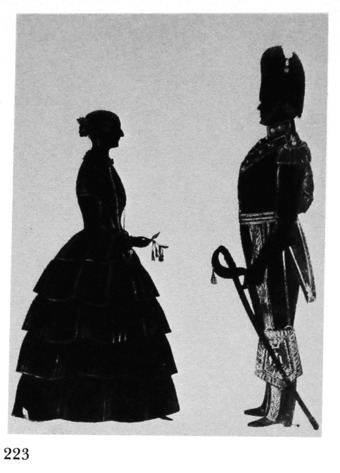
Unknown woman and officer of the 2nd Royal (North British) Dragoons, later the Royal Scots Greys, now the Duke of Kent’s Regiment.
Silhouette by Samuel Metford, probably c. 1848-50.
costume dating points
Woman
The bun, plaited at the back of the head and brought down smoothly over the ears.
The bodice of the dress, with small turn-down collar and set low over the shoulders.
The bell sleeve to the dress, with engageantes.
The skirt, with tiered flounces.
The tiny shoe, just showing.
The pendant earrings, ant the watch on the long fine chain dangling from the neck.
Officer
The bearskin. It was laid down in the Official Regulation for Officers’ Dress (1846) that members of this regiment could wear hackle feather, worn on the left.
The regimental badge (showing a grenade) is visible on the collar.
The shoulder strap, worn by cavalry regiments from the left shoulder to the right hip.
The gold stripe on the trousers, also stipulated for this regiment in the regulations, is visible.
The sabretache, introduced for the cavalry after 1811, bears both the Waterloo eagle of the regiment and the initials V. R., indicating a date after 1837.
The curved sabre, carried at this date by certain regiments.
The spurs of course indicate a cavalry regiment.
Author’s collection
Chapter 9
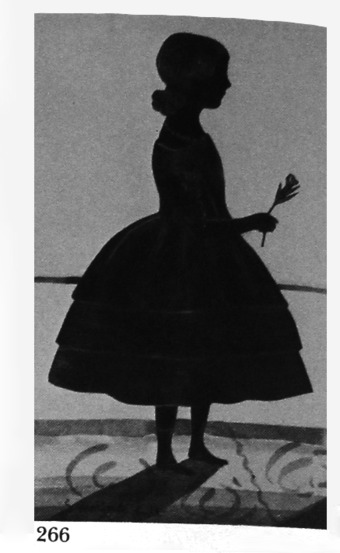
Unknown girl (aged eleven to twelve)
Detail of a group silhouette by Samuel Metford, c. 1850.
costume dating points
The hair, combed flat over the ears and drawn behind in a cluster of curls (farther back than that of the girl, of about the same age, shown in 265).
The necklace.
The dress: low-necked, though less so than was fashionable in the 1840s and with a wider and shorter skirt (with flounces, like those worn by women in the 1850s). The sleeve is of the en bouffant type.
The Gothic angle at the waist has widened, and is not drawn in as tightly as that of the little girl shown in 265.
The girl is probably wearing the soft kid boots which were fashionable during 1850s.
The toes, unlike those of boys’ boots, are not made in stronger leather.
Private collection
SECTION ONE
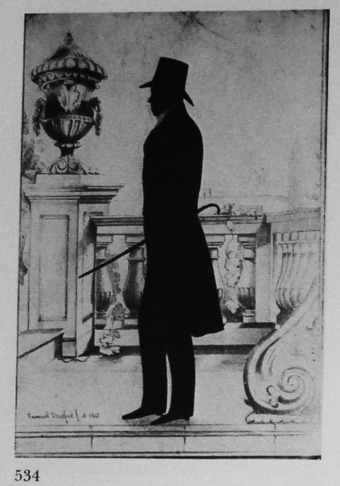
Unknown man
Cut silhouette, with lithograph background
1845
Probably taken in the north of England; signed ‘Samuel Metford fecit 1845’. Compare the background with that in 536.
Warrington Municipal Library
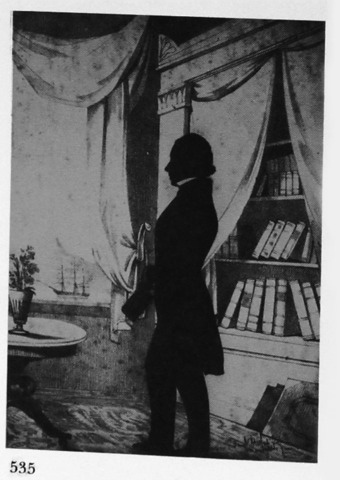
Unknown man
Cut silhouette, with lithograph background
8 June 1846
The background includes a view of a sailing ship seen through a window: a feature typical of Metford’s work.
Signed ‘Saml. Metford fecit. Manchester June 8th, 1846’.
From the collection of the late J. C. Woodiwiss
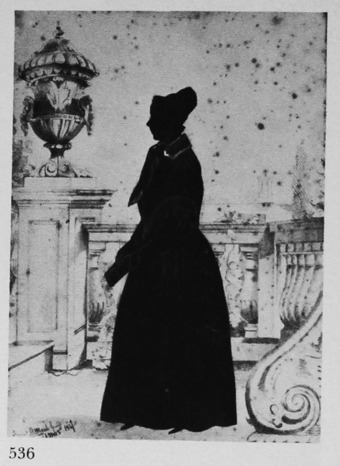
Unknown woman
Cut silhouette, with detail painted in Chinese white and lithograph background
2 November 1847
The background is similar to that in 534, although this silhouette was taken two years later. Notice the sitter’s fashionable Victoria sleeve. Signed ‘Saml. Metford fect. Nov. 2nd 1847’.
Warrington Municipal Library
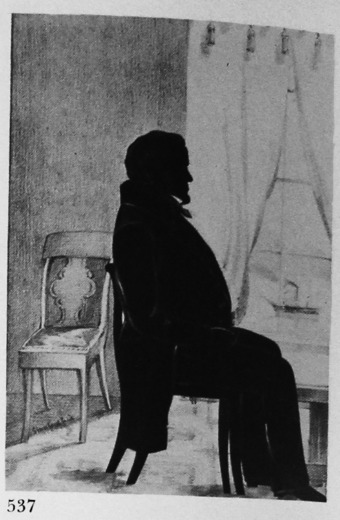
John Rylands, of Bewsey House, Warrington
Cut silhouette, with detail painted in Chinese white and lithograph background
? Late 1840s
8½ x 6½in./216 x 165mm.
Frame: ebonised wood; with trade label of Wynne of Birkenhead
The background, like that in 535, includes a view of a ship seen through a window. Signed ‘S. Metford fecit’.
Author’s collection
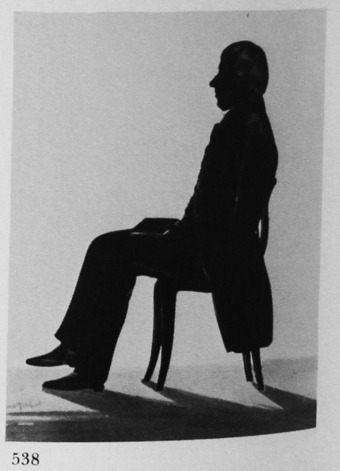
Antony Fewster
Cut silhouette, with detail painted in gold and painted shadow base
? Late 1840s
9½ x 7in./242 x 178mm.
The probable date is suggested by the sitter’s ‘lank’ hair-style and (apparently) half-boots. Signed ‘S. Metford decit’.
Author’s collection
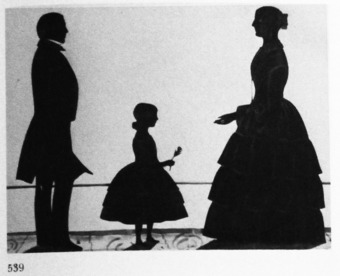
Family group
Cut silhouette, with detail painted in yellow ochre and with painted background
? 1848-50
9 ½ x 11in./242 x 280mm.
The family is dressed for the evening. Note the similarity of the figure of the woman to that of the woman in the silhouette (probably taken at the same period) shown in 223, and the similarity of their dressed and necklaces. The painted background of concentric circles was favoured by several artists. Signed ‘S. Metford fecit’.
In private possession
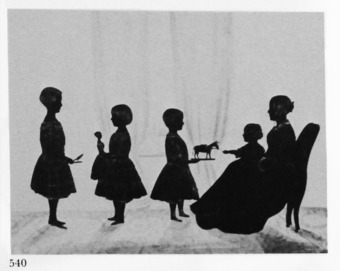
Family group
Cut silhouette, with detail painted in white and gold and with wash background
? 1850-52
14 x 15in./356 x 382mm.
The girl in the left is wearing a plaid dress, fashionable at the time. The hair of the doll held by the younger girl is dressed in the same style as that of the girl’s mother.
R. Kilner collection

Typical signature of Samuel Metford on the front of a silhouette.
DETAIL
641
Detail from a silhouette of a man by Samuel Metford, showing the sitter’s strapped pantaloons and half-boots. The heels are cut disproportionately small: a typical feature of Metford’s work. (538)
Present location unknown
